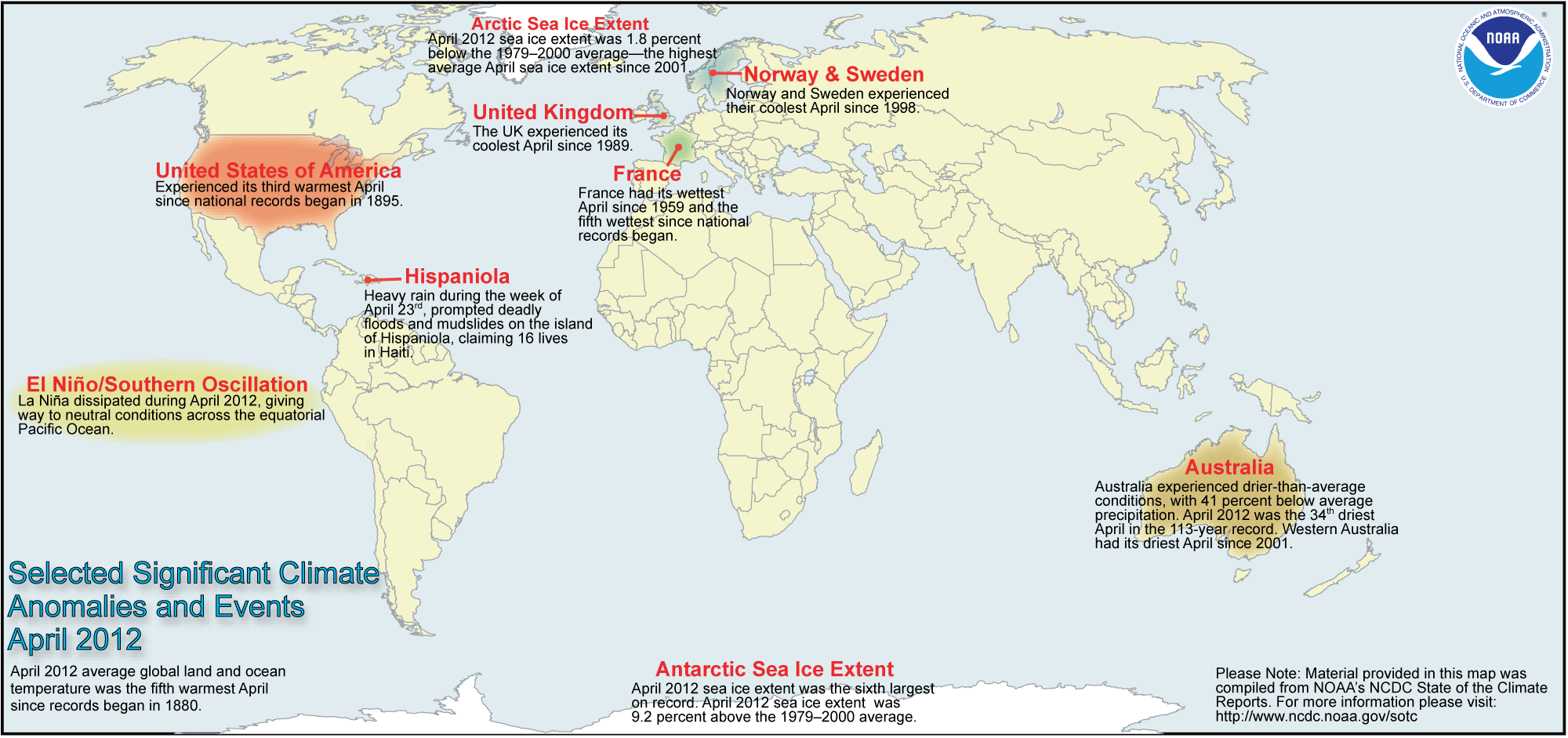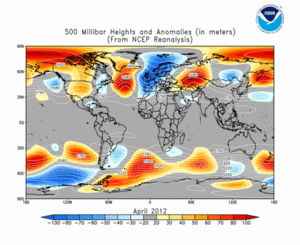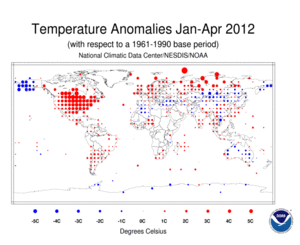 April 2012 Selected Climate
April 2012 Selected Climate
Anomalies and Events Map
Global Highlights
- The combined average temperature over global land and ocean surfaces for April 2012 was 14.35°C (57.87°F), which is 0.65°C (1.17°F) above the 20th century average of 13.7°C (56.7°F). The margin of error associated with this temperature is ±0.08°C (0.14°F). The global temperature departure from the 20th century average and the monthly rank were the highest since November 2010, near the onset of first back-to-back La Niñas in 2010.
- The global land surface temperature was 1.39°C (2.50°F) above the 20th century average of 8.1°C (46.5°F), making this the second warmest April, behind 2007. The margin of error is ±0.11°C (0.20°F).
- For the ocean, the April global sea surface temperature was 0.38°C (0.68°F) above the 20th century average of 16.0°C (60.9°F)—the 11th warmest April on record. The margin of error is ±0.04°C (0.07°F).
Introduction
The data presented in this report are preliminary. Ranks and anomalies may change as more complete data are received and processed.
Temperature anomalies for April 2012 and January–April 2012 are shown on the dot maps in the following section. The dot maps on the left provide a spatial representation of anomalies calculated from the Global Historical Climatology Network (GHCN) version 3.1.0 dataset of land surface stations using a 1961–1990 base period. The dot maps on the right are a product of a merged land surface and sea surface temperature (SST) anomaly analysis developed by Smith et al. (2008). For the merged land surface and SST analysis, temperature anomalies with respect to the 1971–2000 average for land and ocean are analyzed separately and then merged to form the global analysis. For more information, please visit NCDC's Global Surface Temperature Anomalies page.
Temperatures
In the atmosphere, 500-millibar height pressure anomalies correlate well with temperatures at the Earth's surface. The average position of the upper-level ridges of high pressure and troughs of low pressure—depicted by positive and negative 500-millibar height anomalies on the  April 2012 map—is generally reflected by areas of positive and negative temperature anomalies at the surface, respectively.
April 2012 map—is generally reflected by areas of positive and negative temperature anomalies at the surface, respectively.
April
Unlike March 2012, where extremely cool and warm temperatures engulfed much of the Northern Hemisphere land surfaces, most of the world's land areas experienced warmer-than-average temperatures during April 2012. The most notable warmth was observed across Russia, the United States, Alaska, and parts of the Middle East and western Europe. After experiencing very warm March temperatures, parts of western Europe experienced cooler-than-average temperatures, and in some locations the April 2012 temperatures were cooler than the March 2012 temperatures. Other areas that experienced cooler-than-average conditions during the month include southern South America, southeastern Africa, and northern Australia. Globally, the April 2012 land-only surface temperature was 1.39°C (2.50°F) above the 20th century average of 8.1°C (46.5°F)—the second warmest April in the 133-year record, behind 2007. This was also the warmest land-only monthly temperature departure from the 20th century average since November 2010 and the 137th consecutive month with global land temperatures above the 20th century average. The last time land-only worldwide temperatures were below average was November 2000 (0.02°C/0.04°F below average). Of note, the Northern Hemisphere land surface temperature was 1.74°C (3.13°F) above the 20th century average, marking the warmest April since records began in 1880.
Several national highlights are found below:
- The contiguous United States had a mean temperature of 13.2°C (55.7°F) in April 2012, which was 2.0°C (3.6°F) above the 20th century average, resulting in the third warmest April since national records began in 1895. Please visit NCDC's National State of the Climate report for additional information.
- The United Kingdom's (UK) mean temperature during April 2012 was 0.6°C (1.1°F) below the 1971–2000 average—the coolest April mean temperature since 1989. According to the UK's Met Office, April 2012 was cooler than March 2012, an unusual event that last happened in 1998. For the first time since April 1989, April daily temperatures never reached 20°C (68°F). Provisionally, England, Wales, and Scotland had their coolest April since 1989, while Northern Island experienced its coolest April since 2000.
- Spain experienced below-average temperatures during April 2012. According to Spain's National Agency of Meteorology (Agencia Estatal de Meteorología), the April 2012 national mean temperature was 12.1°C (53.8°F), which is 0.2°C (0.4°F) below the 1971–2000 average.
- According to Norway's Institute of Meteorology (Meteorologisk Institutt), Norway experienced cooler-than-average temperatures during April 2012. Temperatures during the month were 0.2°C (0.4°F) below average. This was the coolest April since 1998.
- Sweden also had its coolest April since 1998, according to the Swedish Meteorological and Hydrological Institute (SMHI).
- According to Germany's Weather Service (Deutscher Wetterdienst), Germany as a whole had a mean temperature of 8.1°C (46.9°F), which is 0.8°C (1.4°F) above the 1961–1990 average and the 47th warmest (or 86th coolest) April since national records began in 1881.
- In Antarctica, the South Pole station reported below-average temperatures during April 2012, with an average temperature of -59.6°C (-75.3°F), which is 2.1°C (3.8°F) below average. On April 6th, a new daily minimum temperature record was set when temperatures fell to -73.4°C (-100.1°F), surpassing the previous record of -71.7°C (-97.1°F) set in 1982. The period of record covers 1957–2012. The April 6th minimum temperature also broke the record for the earliest recording of -73.3°C (-100.0°F) at the South Pole station. The previous record of -75.2°C (-103.4°F) was set on April 7, 1982.
The worldwide ocean temperature during April 2012 was 0.38°C (0.68°F) above the 20th century average of 16.0°C (60.9°F)—the coolest April since 2008 and tied with 2011 as the eleventh warmest April on record. April 2012 was the 427th consecutive month with ocean temperatures warmer than the 20th century average. The last time the ocean temperatures were below average was September 1976 (0.01°C/0.02°F below average). A snapshot of the global temperatures indicates that warmer-than-average temperatures were observed across the North Atlantic, north-central Pacific Ocean, and across the mid-latitude southern oceans. Cooler-than-average conditions were present across the northeastern and central Pacific Ocean, parts of the southern half of the South Atlantic Ocean, and across the higher latitudes of the southern oceans. The El Niño-Southern Oscillation (ENSO), which is a climate pattern defined by a periodic fluctuation in sea surface temperature (El Niño) and the air pressure of the overlying atmosphere (Southern Oscillation) across the equatorial Pacific Ocean, transitioned from La Niña phase to neutral conditions during April 2012, as temperatures across the equatorial Pacific Ocean continued to warm. According to NOAA's Climate Prediction Center (CPC), ENSO-neutral conditions are expected to persist through the Northern Hemisphere summer 2012.
Averaging the global land and ocean as a whole, the combined land and ocean surface temperature during April 2012 was 0.65°C (1.17°F) above the 20th century average of 13.7°C (56.7°F), marking the fifth warmest April since records began in 1880 and the 326th consecutive month with a global temperature above the 20th century average. February 1985 was the last month with below-average temperatures, at 0.01°C (0.02°F) below average. This was also the warmest global land and ocean surface temperature anomaly since November 2010, near the onset of first back-to-back La Niñas in 2010.
| April | Anomaly | Rank (out of 133 years) |
Records | |||
|---|---|---|---|---|---|---|
| °C | °F | Year(s) | °C | °F | ||
| Global | ||||||
| Land | +1.39 ± 0.11 | +2.50 ± 0.20 | 2nd Warmest | Warmest: 2007 | +1.44 | +2.59 |
| 132nd Coolest | Coolest: 1905 | -0.79 | -1.42 | |||
| Ocean | +0.38 ± 0.04 | +0.68 ± 0.07 | 11th Warmest | Warmest: 1998, 2010 | +0.56 | +1.01 |
| 123rd Coolest | Coolest: 1911 | -0.53 | -0.95 | |||
| Ties: 2011 | ||||||
| Land and Ocean | +0.65 ± 0.08 | +1.17 ± 0.14 | 5th Warmest | Warmest: 2010 | +0.75 | +1.35 |
| 129th Coolest | Coolest: 1909 | -0.52 | -0.94 | |||
| Northern Hemisphere | ||||||
| Land | +1.74 ± 0.14 | +3.13 ± 0.25 | 1st Warmest | Warmest: 2000* | +1.62* | +2.92* |
| 133rd Coolest | Coolest: 1905 | -1.05 | -1.89 | |||
| Ocean | +0.37 ± 0.04 | +0.67 ± 0.07 | 9th Warmest | Warmest: 2010 | +0.59 | +1.06 |
| 125th Coolest | Coolest: 1911 | -0.52 | -0.94 | |||
| Ties: 2001 | ||||||
| Land and Ocean | +0.89 ± 0.11 | +1.60 ± 0.20 | 1st Warmest | Warmest: 2007+, 2010+ | +0.87+ | +1.57+ |
| 133rd Coolest | Coolest: 1909 | -0.59 | -1.06 | |||
| Southern Hemisphere | ||||||
| Land | +0.47 ± 0.14 | +0.85 ± 0.25 | 23rd Warmest | Warmest: 2005, 2007 | +1.07 | +1.93 |
| 111st Coolest | Coolest: 1917 | -0.76 | -1.37 | |||
| Ties: 2011 | ||||||
| Ocean | +0.41 ± 0.05 | +0.74 ± 0.09 | 14th Warmest | Warmest: 1998 | +0.61 | +1.10 |
| 120th Coolest | Coolest: 1911 | -0.52 | -0.94 | |||
| Land and Ocean | +0.42 ± 0.06 | +0.76 ± 0.11 | 16th Warmest | Warmest: 1998 | +0.66 | +1.19 |
| 118th Coolest | Coolest: 1911 | -0.52 | -0.94 | |||
| Ties: 1990, 1991 | ||||||
* Please note that the value depicted as record year (2000) for the Northern Hemisphere land is the second warmest year on record.
+ Please note that the value depicted as record year (2007 and 2010) for the Northern Hemisphere land and ocean tie for the second warmest year on record.
Year-to-date (January–April)
The January–April map of temperature anomalies shows that warmer-than-average temperatures occurred across the contiguous United States, southern Canada, Mexico, southern South America, the United Kingdom, Scandinavia, northern Russia, and parts of southeastern Asia. Cooler-than-average conditions were observed across Alaska, northern Africa, central Asia, eastern Russia, and most of Australia.
The globally-averaged land and ocean temperature for January–April 2012 was 0.46°C (0.83°F) above the 20th century average of 12.6°C (54.8°F), the coolest such period since 2008 and the 15th warmest such period in the 133-year record. The land-only global average temperature anomaly of 0.75°C (1.35°F) above the 20th century average of 4.8°C (40.5°F) ties with 2011 as the 17th warmest such period and was the coolest such period since 1997. Meanwhile, the global ocean temperature tied with 1999 as the 13th warmest such period, with an anomaly of 0.35°C (0.63°F) above the 20th century average of 15.9°C (60.7°F)—the coolest January–April anomaly since 2008.
- The contiguous United States mean temperature during January–April was 7.4°C (45.4°F), which is 3.0°C (5.4°F) above the long-term average and the warmest such period since national records began in 1895. Please visit NCDC's National State of the Climate report for additional information.
- According to Norway's Institute of Meteorology (Meteorologisk Institutt), the January–April 2012 temperature for the country as a whole was 1.7°C (3.1°F) above the 1961–1990 average, resulting in the 20th warmest such period since national records began in 1900.
| January–April | Anomaly | Rank (out of 133 years) | Records | ||||
|---|---|---|---|---|---|---|---|
| °C | °F | Year(s) | °C | °F | |||
| Global | |||||||
| Land | +0.75 ± 0.22 | +1.35 ± 0.40 | Warmest | 17th | 2007 | +1.38 | +2.48 |
| Coolest | 117th | 1893 | -1.04 | -1.87 | |||
| Ties: 2011 | |||||||
| Ocean | +0.35 ± 0.04 | +0.63 ± 0.07 | Warmest | 13th | 1998, 2010 | +0.56 | +1.01 |
| Coolest | 121st | 1911 | -0.51 | -0.92 | |||
| Ties: 1999 | |||||||
| Land and Ocean | +0.46 ± 0.09 | +0.83 ± 0.16 | Warmest | 15th | 2010 | +0.71 | +1.28 |
| Coolest | 119th | 1911 | -0.53 | -0.95 | |||
| Northern Hemisphere | |||||||
| Land | +0.87 ± 0.26 | +1.57 ± 0.47 | Warmest | 18th | 2007 | +1.58 | +2.84 |
| Coolest | 116th | 1893 | -1.25 | -2.25 | |||
| Ocean | +0.32 ± 0.05 | +0.58 ± 0.09 | Warmest | 13th | 2010 | +0.55 | +0.99 |
| Coolest | 121st | 1904, 1908, 1911 | -0.46 | -0.83 | |||
| Land and Ocean | +0.53 ± 0.14 | +0.95 ± 0.25 | Warmest | 16th | 2007 | +0.89 | +1.60 |
| Coolest | 118th | 1893 | -0.71 | -1.28 | |||
| Ties: 2008 | |||||||
| Southern Hemisphere | |||||||
| Land | +0.43 ± 0.14 | +0.77 ± 0.25 | Warmest | 22nd | 2010 | +1.02 | +1.84 |
| Coolest | 112th | 1917 | -0.80 | -1.44 | |||
| Ties: 1969 | |||||||
| Ocean | +0.38 ± 0.04 | +0.68 ± 0.07 | Warmest | 15th | 1998 | +0.60 | +1.08 |
| Coolest | 119th | 1911 | -0.53 | -0.95 | |||
| Ties: 2000 | |||||||
| Land and Ocean | +0.39 ± 0.07 | +0.70 ± 0.13 | Warmest | 17th | 1998 | +0.65 | +1.17 |
| Coolest | 117th | 1911 | -0.54 | -0.97 | |||
| Ties: 1973 | |||||||
| Arctic | |||||||
| Land and Ocean | +1.20 ± 0.33 | +2.16 ± 0.59 | Warmest | 14th | 1995 | +1.97 | +3.55 |
| Coolest | 120th | 1966 | -2.24 | -4.03 | |||
The most current data may be accessed via the Global Surface Temperature Anomalies page.
Precipitation
The maps below represent anomaly values based on the GHCN version 2 dataset of land surface stations using a base period of 1961–1990. During April 2012, above-average precipitation fell over areas that included the central and northwestern United States, and parts of northern and southern South America, Europe, and eastern Asia. Drier-than-average conditions were present across the eastern United States, the Hawaiian Islands, eastern Brazil, and southern parts of South America, and Australia.
- The decline of the La Niña brought to an end the wet conditions that eastern Australia had been experiencing for several months. According to Australia's Bureau of Meteorology, Australia experienced drier-than-average conditions across most of the nation, with 41 percent below-average rainfall. This was the 34th driest April in the nations 113-year record. Western Australia experienced 57 percent below-average precipitation in April, which was the lowest since April 2001.
- The United Kingdom received a total of 126.5 mm (5.0 inches) of precipitation during April 2012, which is the UK's wettest April since national records began in 1910. Provisionally, England had its wettest April on record, and also tied with 1998 with the highest number of rainy days in April in the last five decades.
- France experienced above-average precipitation, with 70 percent above average. This was France's wettest April since 1959 and fifth wettest since national records began.
References
Peterson, T.C. and R.S. Vose, 1997: An Overview of the Global Historical Climatology Network Database. Bull. Amer. Meteorol. Soc., 78, 2837-2849.
Quayle, R.G., T.C. Peterson, A.N. Basist, and C. S. Godfrey, 1999: An operational near-real-time global temperature index. Geophys. Res. Lett., 26, 333-335.
Smith, T.M., and R.W. Reynolds (2005), A global merged land air and sea surface temperature reconstruction based on historical observations (1880-1997), J. Clim., 18, 2021-2036.
Smith, et al (2008), Improvements to NOAA's Historical Merged Land-Ocean Surface Temperature Analysis (1880-2006), J. Climate., 21, 2283-2293.
 NOAA's National Centers for Environmental Information
NOAA's National Centers for Environmental Information









